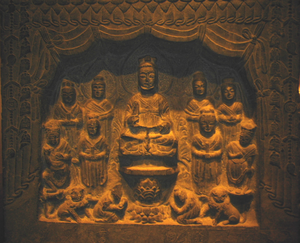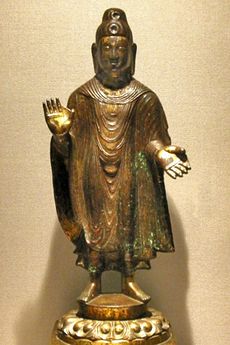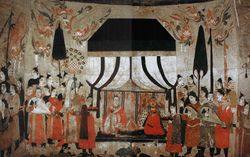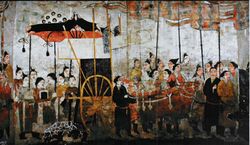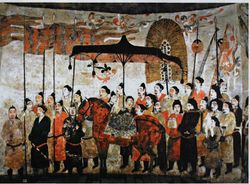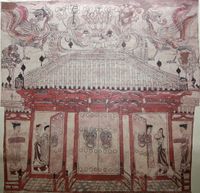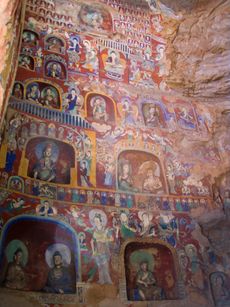الأسر الشمالية والجنوبية
| الأسر الشمالية والجنوبية (420–589) | |||
|---|---|---|---|
| الأسر الشمالية | الأسر الجنوبية | ||
| وِيْ الشمالية 386–535 | |||
| ليو سونگ 420–479 | |||
| چي الجنوبية 479–502 | |||
| ليانگ 502–557 | |||
| وِيْ الغربية 535–557 | وِيْ الشرقية 534–550 | ||
| ژو الشمالية 557–581 | چي الشمالية 550–577 | تشن 557–589 | ليانگ الغربية 555–587 |
| الأسر الشمالية والجنوبية | |||
|---|---|---|---|
 الأراضي التقريبية لدولتي وِيْ الشمالية (أزرق) و ليو سونگ (كستنائي) في 440 | |||
 الأسر الشمالية والجنوبية في 560 | |||
| الصينية | 南北朝 | ||
| |||
أظهر
القديم | |||
أظهر
الامبراطوري | |||
أظهر
المعاصر | |||
أظهر
مقالات ذات صلة | |||
الأسر الشمالية والجنوبية (Chinese: 南北朝; pinyin: Nán-Běi Cháo) كانت فترة في تاريخ الصين امتدت من 420 حتى 589، إثر العصر المضطرب للممالك الستة عشر ودويلات وو هو. وأحياناً تـُعتبر الجزء اللاحق من فترة أطول تـُعرف بإسم الأسر الست (220 إلى 589).[1] وبالرغم من أنه عصر حرب أهلية واضطراب سياسي، فقد كان أيضاً عصر ازدهار للفنون والثقافة وتقدم التكنولوجيا، وانتشار بوذية المهايانا و الطاوية. وشهدت الفترة هجرات كبرى لصينيي الهان إلى الأراضي جنوب نهر يانگتسى. وقد انتهت الفترة بتوحيد كل الصين الداخلية على يد الامبراطور ون من أسرة سوي.
وأثناء هذه الفترة، تسارعت عملية التصين بين القادمين غير الصينيين في الشمال وبين الشعوب الأصلية في الجنوب. هذه العملية رافقها شعبية متزايدة للبوذية (التي قـَدَمت إلى الصين في القرن الأول) في كل من الصين الشمالية والجنوبية كما حازت الطاوية على نفوذ، إذ كـُتـِب نصان أساسيان للطاوية أثناء تلك الفترة.
شهدت الفترة إنجازات تكنولوجية بارزة. فاختراع ركاب السرج في مطلع أسرة جين (265–420) حفـَّز نشأة الفروسية الثقيلة كمكون رئيسي في القتال. كما لاحظ المؤرخون وثبات في الطب والفلك والرياضيات ورسم الخرائط. مثقفو الفترة ضموا عالم الرياضيات والفلكي زو تشونگژي (429–500).
خلفية
بعد انهيار الصين الموحدة تحت أسرة هان في 220، لحد كبير، بسبب تمردات العمامات الصفر و مناقير الأرز الخمس، إلتأمت الصين، أخيراً، في الممالك الثلاث. وبينهن، تساو وِيْ كانت الأقوى، تليها وو الشرقية و شو هان، إلا أنهم كن في بادئ الأمر تشكيلات مستقرة نسبياً. وبعد انقلاب في 249 قام به سيما يي، سيطرت أسرة سيما على تساو وِيْ و conquest of Shu by Wei تلتها على الفور.
Following a failed coup by the ruling Cao family against the Sima family, the final Cao ruler abdicated. Sima Yan then founded the Jin Dynasty as Emperor Wu of Jin and the conquest of Wu by Jin occurred in 280, ending the Three Kingdoms period and reuniting China.
The Jin dynasty was severely weakened after the War of the Eight Princes from 291-306. During the reigns of Emperor Huai and Emperor Min, the country was put into grave danger with the uprising of the northern non-Han people collectively known as the Five Barbarians. Invading non-Han armies almost destroyed the dynasty in the Disaster of Yongjia of 311, when the Five Barbarians sacked Luoyang. Chang'an met a similar fate in 316.
However, a scion of the royal house, Sima Rui, Prince of Langya, fled south of the Huai River to salvage what was left in order to sustain the empire, establishing himself as Emperor Yuan. Cementing their power in the south, the Jin established Jiankang on the existing site of Jianke (now Nanjing) as their new capital, renaming the dynasty as the Eastern Jin since the new capital was located southeast of Luoyang.
الأسر الشمالية
بزوغ وِيْ الشمالية (386–535) وحركة التصيـُّن
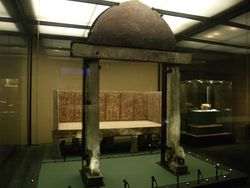
وِيْ الشرقية (534–550)
وِيْ الغربية (535–557)
چي الشمالية (550–577)
ژو الشمالية (557–581)
الأسر الجنوبية

ليو سونگ (420–479)
چي الجنوبية (479–502)
ليانگ (502–557)
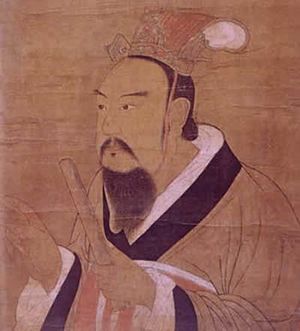
تشن (557–589)
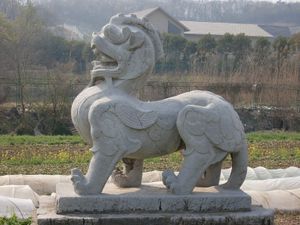
الثقافة
الفلسفة
الأدب
فنون أخرى
تغيرات ديمغرافية
It was during the Northern and Southern dynasties period that the earliest recorded migration of ethnic Han Chinese to southern China (below the Yangtze River) took place. This sinicisation helped to develop the region from its previous state of being inhabited by only small and isolated communities separated by vast uncolonized wilderness of non-Chinese ethnic groups. During this period, the south went from being nearly a frontier to being on a path to the thriving, urbanized, sinicized region that it became in later centuries. In his book Buddhism in Chinese History, Arthur F. Wright points out this fact by stating:
"When we speak of the area of the Yangtze valley and below in the period of disunion, we must banish from our minds the picture of the densely populated, intensively cultivated South China of recent centuries. When the aristocrats of the remnants of the Chin [Jin] ruling house fled to the Nanking [Nanjing] area early in the 4th century, the south contained perhaps a tenth of the population of China. There were centers of Chinese culture and administration, but around most of these lay vast uncolonized areas into which Chinese settlers were slow to move".[2]
خرائط
انظر أيضاً
- Timeline of the Northern and Southern dynasties
- Chinese sovereign
- List of tributaries of Imperial China
- Buddhism in China
- Empress Dowager Hu (Northern Wei)
- Yan Zhitui
- Jinping Commandery
Notes
المراجع
- ^ Gascoigne, Bamber (2003). The dynasties of China : a history (1st Carroll & Graf ed.). New York: Carroll & Graf Publishers. ISBN 978-0786712199.
- ^ Wright, Arthur F. (1959). Buddhism in Chinese History. Stanford: Stanford University Press. Page 44.
للاستزادة
- Boodberg, Peter A. (1938). "Marginalia to The Histories of The Northern Dynasties". Harvard Journal of Asiatic Studies. 3 (3/4): 223–253. JSTOR 2717776.
- ——— (1939). "Marginalia to The Histories of The Northern Dynasties". Harvard Journal of Asiatic Studies. 4 (3/4): 230–283. JSTOR 2717776.
- Graff, David A. Medieval Chinese Warfare, 300–900. ISBN 0-415-23954-0.
- Ebrey, Patricia Buckley; Walthall, Anne; Palais, James B. (2006). East Asia: A Cultural, Social, and Political History. Boston: Houghton Mifflin. ISBN 978-0-618-13384-0.
- Lewis, Mark Edward (2009). China between Empires: The Northern and Southern Dynasties. Harvard University Press. ISBN 978-0-674-02605-6.
- Miller, Roy Andrew (1959): Accounts of Western Nations in the History of the Northern Chou Dynasty. University of California Press.
- Wright, Arthur F. (1959). Buddhism in Chinese History. Stanford: Stanford University Press.
وصلات خارجية
- Period of the Northern and Southern Dynasties
- Early Imperial China: A Working Collection of Resources
| سبقه أسرة جين |
Dynasties in Chinese history 420–589 |
تبعه أسرة سوي |
- Articles containing صينية-language text
- Articles containing Chinese-language text
- Articles with hatnote templates targeting a nonexistent page
- الأسر الشمالية والجنوبية
- دول وأقاليم تأسست في the 420s
- States and territories disestablished in the 580s
- أسر حاكمة في التاريخ الصيني
- القرن الخامس في الصين
- القرن السادس في الصين
- Medieval Asia
- تأسيسات 420
- تأسيسات القرن الخامس في الصين
- انحلالات 589
- انحلالات القرن السادس في الصين

